SAT Math 1 & 2 Subject Tests
Chapter 18
Level 1 Practice Test Form B Answers and Explanations
1 D All three people weigh 410 pounds, but Rob and Sherry weigh 300 pounds; therefore, Heather must weigh 410 − 300 = 110 pounds. Because Sherry and Heather weigh 240 pounds, Sherry must weigh 240 − 110 = 130 pounds. If you don”t want to handle the question this way, you can simply PITA. That means starting with (C) and using the answer choices as Sherry”s weight. For example, if Sherry”s weight is 120 pounds, that makes Rob”s weight 180 pounds and Heather”s weight 120 pounds. Those three weights don”t add up to 410 pounds, so move on and try the next answer choice. Answer choice (D) works.
2 C Draw a rough sketch:
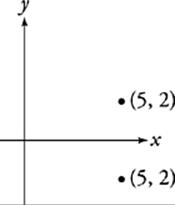
The point (5, 2) is 2 units above the x-axis, so its reflection will be 2 units below the x-axis. Reflecting the point across the x-axis keeps the x-coordinate the same but changes the sign of the y-coordinate.
3 E This is just Plugging In. Plug the values given for r and s into the equation. =
= =
= =
= =
=![]() = 9 + 9 = 18
= 9 + 9 = 18
4 A You”re given variables and no numbers, so Plug In. Suppose p = 60. The other two interior angles of the triangle must then add up to 120°. For now, Plug In 50 and 70, making the angle above n a 50° angle, and the angle above m a 70° angle. Then, because there are 180° in a straight line, you know that n = 130 and m = 110. Now that you have values for each of the variables, you can go to the answer choices and see which one works. You”re looking for the answer choice that is equal to p, or 60. Only (A) works, and that”s the correct answer.
5 B You”ve got variables in the question and the answer choices, so Plug In. Suppose that you”re traveling 5 miles (b = 5). That means that your fare will include an original $2.50 plus five $0.30 charges ($1.50) for each of the 5 miles traveled (which is $7.50), for a total of $9.00. To find the correct answer, plug b = 5 into the answer choices and see which one gives you a value of 9. Only (B) does the trick.
6 D You have to set up two different equations. The first is if what”s in the absolute value is nonnegative, and the other if what”s inside the absolute value is negative. The first equation is y − 3 = 4y − 7, which simplifies to y = ![]() . That”s not in the answers. So let”s set up the second equation: −(y − 3) = 4y − 7. This simplifies to 3 − y = 4y − 7, which becomes 5y = 10 and y = 2.
. That”s not in the answers. So let”s set up the second equation: −(y − 3) = 4y − 7. This simplifies to 3 − y = 4y − 7, which becomes 5y = 10 and y = 2.
7 E You may recognize that this is the point-slope form and that the slope is ![]() . If you don”t see that, rewrite the equation into slope-intercept form.
. If you don”t see that, rewrite the equation into slope-intercept form.
8 B Substitute for a and b. So a2 + b2 = cos2 θ + sin2 θ. But you know the identity cos2 θ + sin2 θ = 1, so the answer is (B).
9 B A friendly reminder—the perimeter is what you get when you add up all a polygon”s sides. The most common careless mistake on perimeter questions is to calculate the area instead. Notice answer choice (E).
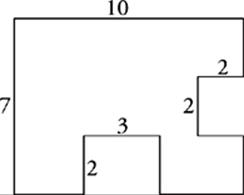
Figure 2
In the end, this is a simple addition question. The polygon can be seen as a 7 × 10 rectangle with two notches cut into it. The notches add to the polygon”s perimeter, but figuring out how much they add is the tricky part. A plain 7 × 10 rectangle has a perimeter of 34. The notch cut into the bottom of this rectangle adds 4 units to this perimeter, not 7. The three horizontal segments on the bottom of the figure must still add up to 10, the length of the rectangle; only the vertical segments add length. In the same way, the notch cut into the right side of the rectangle adds 4 units of length, not 6, because the vertical sides must still add up to 7, the rectangle”s height; only the horizontal segments add length. The total perimeter is 34 + 4 + 4, or 42.
10 A The thing to be careful about here is taking the absolute value at the right time. To find |x + y|, you have to add x and y together first, and then take the absolute value. If you take the absolute value of each quantity before adding, you”re likely to get a wrong answer. The only pair of coordinates whose sum has an absolute value greater than 5 is (A), because −4 + −2 = −6, and |−6| = 6.
11 B Keri sold more than 300 units in only four months in 1996: March, August, September, and December. That means four bonuses, for a total of $4,000.00.
12 D The trick here is to remember the bonuses. In the 3-month periods shown in answer choices (A), (B), and (E), Keri sold 1,000 units, earning $10,000 in commissions. Each 3-month period also includes one bonus, raising her income for that period to $11,000.00. In the 3-month period shown in answer choice (D), however, Keri earns more. She sells 950 units, earning $9,500.00 in commissions, and also receives two bonuses, for a total of $11,500.00.
13 E Set up a proportion: ![]() =
= ![]() . Simplify: 4a = 350, and a = 87.5. You can also approximate. When b goes up, a goes up. So you can eliminate (A) and (B).
. Simplify: 4a = 350, and a = 87.5. You can also approximate. When b goes up, a goes up. So you can eliminate (A) and (B).
14 C It”s algebra time. Whenever two fractions are equal, you can cross-multiply.

You”re not done when you”ve solved for x, though. The question asks not for x, but for ![]() . To produce the right answer, you have to divide by 3.
. To produce the right answer, you have to divide by 3.
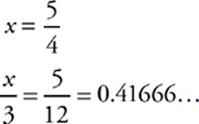
15 A The four right triangles inside the quadrilateral are congruent; they have legs and hypotenuses of equal length. The exact lengths of the segments don”t matter. For convenience”s sake, you can Plug In values for the lengths. Suppose that the right triangles are all 3-4-5 triangles. That makes the hypotenuses 5.
The value of sin ∠RSU, according to SOHCAHTOA, will now be ![]() . The correct answer choice will be the one that also equals
. The correct answer choice will be the one that also equals ![]() . Answer choice (A) is correct.
. Answer choice (A) is correct.
16 D There are two common sorts of nonreal numbers that are important on the Math Subject Tests. These are the square roots of negative numbers (imaginary numbers) and numbers divided by zero (undefined). The expression  will therefore be real only if x is zero or greater (so that the quantity under the radical isn”t negative) and only if x doesn”t equal 3 (so that the fraction”s denominator isn”t zero). You can see that x doesn”t have to be greater than 1 (x = 0 is allowed, for example), so Statement I is out. This allows you to eliminate (A), (C), and (E). Statement II is definitely true because it is in both remaining answer choices. Statement III must also be true, since x must be greater than or equal to zero. The correct answer is (D).
will therefore be real only if x is zero or greater (so that the quantity under the radical isn”t negative) and only if x doesn”t equal 3 (so that the fraction”s denominator isn”t zero). You can see that x doesn”t have to be greater than 1 (x = 0 is allowed, for example), so Statement I is out. This allows you to eliminate (A), (C), and (E). Statement II is definitely true because it is in both remaining answer choices. Statement III must also be true, since x must be greater than or equal to zero. The correct answer is (D).
17 E Always sketch situations that are described but not shown. Here”s the situation described in the question:
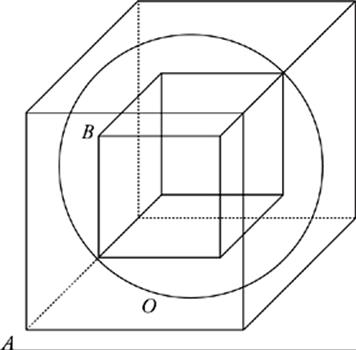
Cube A is the outermost shape. Sphere O is inscribed inside it, and cube B is then inscribed within the sphere. You can use this simple sketch to check your answer choices. As you can see from your sketch, one edge of A is equal in length to the diameter of O, which in turn is equal to the diagonal of B. The correct answer is (E).
18 A This is a fancy simultaneous-equations question. It”s impossible to solve for the value of x, y, or z, but you can find the value of their sum. It”s done by adding the equations, like
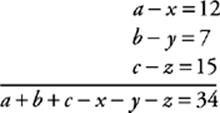
This equation can be written as (a + b + c) − (x + y + z) = 34. And since the question tells you that a + b + c = 50, you can simplify the equation even further:
50 − (x + y + z) = 34
−(x + y + z) = −16
x + y + z = 16
19 B Since Cassie”s stuck in the driver”s seat, the number of permutations of the people in the car is simply determined by the possible arrangements of passengers in the 3 passengers” seats. The number of permutations of 3 items in 3 spaces is given by 3!, which equals 3 × 2 × 1, or 6.
20 E PITA. See which value of x in the answer choices makes the equation true. It”s (E).
21 C Remember that slope is equal to “rise” over “run.” A line that has a slope greater than 1 is changing vertically (along the y-axis) faster than it”s changing horizontally (along the x-axis). Line l might look like
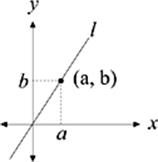
As you can see, a and b don”t have to be equal—in fact, they can”t be. You can also see that a doesn”t have to be less than b—a will be less than b when they”re both positive, but b will be less than a when they”re negative. Of all the statements in the answer choices, only (C) must be true. Since b is always farther from zero than a, its square will always be greater than the square of a.
22 C
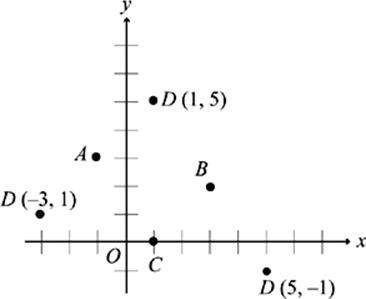
Figure 5
This one is a little tricky. The best way to approach it is by experimenting with sketches. If you examine the possibilities carefully, you”ll see that there are three possible locations of the missing vertex.
23 E PITA works well on this one. Just take the values of x from the answer choices and fill in the values for the other angles using the formulas y = ![]() x and w = 2z. You”ll know you”ve got the right answer when the values produced obey the Rule of 180°. If x = 72, then y =
x and w = 2z. You”ll know you”ve got the right answer when the values produced obey the Rule of 180°. If x = 72, then y = ![]() (72), or 48. The sum of x and y is then 120, which means that w = 120, since it”s a vertical angle. The equation w = 2z gives us z = 60. If you check all those numbers against the Rule of 180°, you”ll see that (E) is the correct answer.
(72), or 48. The sum of x and y is then 120, which means that w = 120, since it”s a vertical angle. The equation w = 2z gives us z = 60. If you check all those numbers against the Rule of 180°, you”ll see that (E) is the correct answer.
24 D The new radius of circle O is (r + t). To find the circle”s area, just plug this quantity into the formula for the area of a circle, A = πr2. To do this, you”ll need to use FOIL.

Alternately, you could Plug In something like r = 5 and t = 3. The new radius is 8, making your target answer π(8)2 or 64π. Only (D) works.
25 C You can find the radius of the circle from the area you”re given, just by plugging the area into the formula and solving.

Because OA and OB are both radii, each must have a length of 3. And because they”re perpendicular, they must be legs of an isosceles right triangle. That means that ΔABO has angles measuring 45°, 45°, and 90°, and must therefore have sides in the ratio 1 : 1 : ![]() . The length of the hypotenuse, AB, is simply 3
. The length of the hypotenuse, AB, is simply 3![]() , or 4.24.
, or 4.24.
26 A Solving x2 + 2x − 3 = 0 is just a matter of factoring.

The funny looking equation x > |x|, however, tells you that x is negative. That means that x can only equal −3. To find the answer, just plug x = −3 into the expression 2x + 4.
2(−3) + 4 = −6 + 4 = −2
27 B The corresponding parts of similar triangles are proportional. To figure out a value in one triangle from the corresponding value in the other, you need to know what the proportion is. Luckily, this question gives you the hypotenuse of both triangles—5 and 4, respectively. This allows you to set up this proportion.

To find the area of ΔCBD, you”ll need to know the lengths of both of its legs. Use the proportion to find these lengths from the legs of the larger triangle. First, find the longer leg, BD:
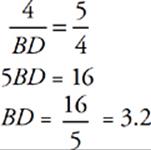
Then, find CD:
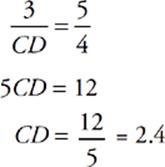
Once you know that ΔCBD is a right triangle with legs 2.4 and 3.2, all you have to do is plug these lengths into the area formula for triangles.

28 D For this question, you need to remember how FOIL works, and that i2 can be replaced by −1.

29 D PITA. Plug each answer choice into the function for x, to see which one spits out −4. (D) works, because f (1) = (1)2 − 5(1) = 1 − 5 = −4.
30 B It”s a good idea to sketch the situation that”s described in this question:
As you can see, only one dimension of this solid is doubled. It”s now a rectangular solid of dimensions 3 × 5 × 8. The longest segment that can be drawn within this solid is the long diagonal, which can be found using the Super Pythagorean theorem.
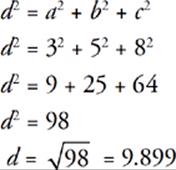
The correct answer is (B).
31 E Type this into your calculator, being careful to use parentheses. You should get either 3025000000 or something like 3.025e9. To get 3025000000 into scientific notation, you need to move the decimal point 9 places to the left, which means your power of 10 will be 9; pick (E).
32 D The probabilities must add up to 1; the probabilities shown in the table add up to ![]() , so n must be
, so n must be ![]() .
.
33 B Don”t let all the scientific talk scare you. All you”re being asked to do is find the value of t for which n = 500. To do that, just PITA. Plug each answer choice in for t, to see which one makes n = 500. (B) works.
34 E Perpendicular lines have opposite reciprocal slopes. That means that if line m has a slope of −![]() , line l, which is perpendicular to it, must have a slope of 2. That alone lets you eliminate the equations in (A), (B), and (C), all of which have the wrong slope. So the answer must be (D) or (E). Since the point (4, 5) is on the line you”re looking for, you can plug that point in for (x, y) in the equation of a line to see whether it makes the equation true. If you plug (4, 5) into (D), you get 5 = 2(4) − 1, which is wrong. Cross off (D)—the answer is (E).
, line l, which is perpendicular to it, must have a slope of 2. That alone lets you eliminate the equations in (A), (B), and (C), all of which have the wrong slope. So the answer must be (D) or (E). Since the point (4, 5) is on the line you”re looking for, you can plug that point in for (x, y) in the equation of a line to see whether it makes the equation true. If you plug (4, 5) into (D), you get 5 = 2(4) − 1, which is wrong. Cross off (D)—the answer is (E).
35 B For this question, it”s important to remember the difference between central angles and inscribed angles. Central angles, like ∠AOB and ∠BOC, are like pie slices that start at the circle”s center. The arcs they intercept are equal in measure to the angles themselves. Inscribed angles, on the other hand, start on the edge of the circle, like ∠BDA and ∠CAD. The arcs they intercept are twice as great in measure as the angles themselves.
Since ∠BDA is an inscribed angle measuring 25°, the arc it intercepts, AB, must measure 50°. For the same reason, the arc intercepted by ∠BDA must measure 64°. That”s a total of 114° out of the semicircle ABCD, which leaves 66° out of the 180° half-circle. That”s the measure of arc BC. Since arc BC measures 66°, the central angle BOC must also measure 66°. The correct answer is (B).
36 A This question tests your understanding of exponent rules. You”re told that 4x + 2 = 48, but how do you solve for 4x? Remember that when you multiply exponential terms that have a common base, you add the exponents. In the same way, you can express addition in an exponent as multiplication.

Once you”ve taken this step, solving is easy.

37 C Just Plug In a number for x. If x = 2, the problem reads r(2) = 17 and s(r(2)) = 3. But that means you can substitute 17 for r(2) in the second equation, so you know that s(17) = 3. Since the problem is asking for s(17), and 3 is your target number, Plug In 17 for x in the answer choices, to see which answer choice hits 3. Only (C) works.
38 C Use the Group Problem Formula, Total = Group 1 + Group 2 + Neither − Both. Here, you”ve got 850 = 250 + 450 + 350 − Both. So Both = 200. Pick (C). You need to memorize this formula!
39 C Rearrange the equation to read 9n = 27, then change each base to 3: (32)n = 33. So 32n = 33, which means that the exponents are equal: 2n = 3. Therefore, n = ![]() .
.
40 A The cylindrical cup has a radius of 2 and a height of 3. Its volume, given by V = πr2h, is π(2)2(3), or 12π. The volume of the rectangular tank, given by V = lwh, is 6 × 7 × 8, or 336. To find out how many times the cup can be filled completely from the tank, just divide 336 by 12πusing your calculator:

As you can see, the cup can be filled almost 9 times, but can be filled completely only 8 times. The correct answer is (A).
41 D Always sketch situations that are described but not shown. The situation described in this question would look something like this:
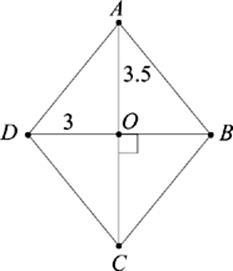
Segments AC and BD form right angles, and each cuts the other exactly in half. Segments BO and DO have lengths of 3, and segments AO and CO have lengths of 3.5. If you sketch segments AB, BC, CD, and DA, then you have four identical right triangles. You can use the Pythagorean theorem to find the length of each hypotenuse.
a2 + b2 = c2
32 + 3.52 = c2
9 + 12.25 = c2
21.25 = c2
c = 4.61
When you know the lengths of each side, you can use SOHCAHTOA to figure out the value of sin ∠ADO. The side opposite ∠ADO is AO, and the hypotenuse is AD. You can use the lengths of these segments to find the value of the trig function.
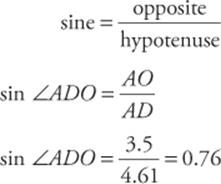
![]()
42 A The interquartile range is the difference between the third quartile and the first quartile; put simply, it”s the width of the entire box in the middle of the boxplot. (A) has an interquartile range of 70 − 10 = 60; no other choice comes close.
43 A Plugging In can work wonders for you on this one. The constant k can be anything. Let”s say it equals 3. If that”s the case, f(x) = 3x, and g(x) = x + 3. Using these values makes it easy to plug into the function to test each of the three statements.
Suppose x = 2, take a look at Statement I. Using your values, you can plug into the statement to see whether it must be true.
f(2x) = 2f(x)
f(4) = 2f(2)
3 × 4 = 2(3 × 2)
12 = 12
Statement I works so far, so let”s keep it and move on. Here”s how Statement II looks with our values plugged into it.
f(x + 2) = f(x) + 2
f(4) = f(2) + 2
3 × 4 = (3 × 2) + 2
12 = 8
Statement II is definitely NOT true, so you can eliminate it. That gets rid of answer choices (B), (C), and (E), leaving only (A) and (D). Since Statement I is present in both answers, you can forget about it. To pick the right answer, you need to check out Statement III.
f(g(x)) = g(f(x))
f(g(2)) = g(f(2))
f(2 + 3) = g(3 × 2)
f(5) = g(6)
3 × 5 = 6 + 3
15 = 9
Statement III definitely isn”t true either, so you can get rid of it. That eliminates answer choice (D), leaving only (A).
44 E This is a Pythagorean theorem question disguised by a complicated physical description. Making a sketch of the southern wall can help clear this up.
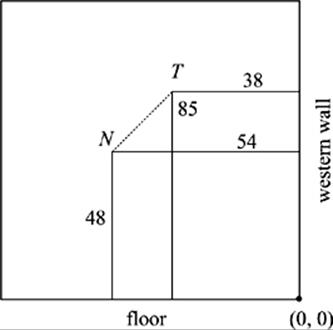
As you can see, the nail and tack can be viewed as points on a coordinate plane. The coordinates of the points are given by their distances from the floor and the western wall. The coordinates of the tack are (−38, 85), and the coordinates of the nail are (−54, 48). These are larger coordinates than you”re used to working with, but you can work with them normally. To find the distance between the tack and nail, use the distance formula.
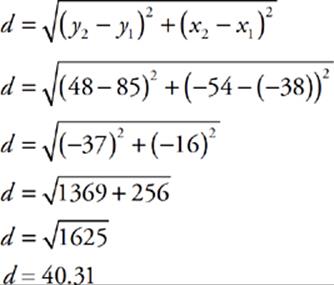
45 C The domain of the function f(x) is the set of values that you”re allowed to plug into the function in the x position. The only numbers not in a function”s domain are those that make the function produce nonreal numbers—that is, fractions with zero in the denominator and even roots of negative numbers. There are no fractions in this function, so any values not in the domain of f will be those that make the square root negative.
For ![]() to be a real number, the quantity under the radical, 12 − x2, must be zero or positive. To find the values of x that make f(x) real, just write that as an inequality, and solve.
to be a real number, the quantity under the radical, 12 − x2, must be zero or positive. To find the values of x that make f(x) real, just write that as an inequality, and solve.
12 − x2 ≥ 0
−x2 ≥ −12
x2 ≤ 12
−![]() ≤ x ≤
≤ x ≤ ![]()
This is the domain of f(x). The correct answer is (C). You could also PITA. Just pick numbers that are in some of the ranges in the answer choices, but not others, and plug them into the function to see if they work.
46 B The basic rule of logic most commonly tested on the Math Subject Tests is the contrapositive. When you see any statement in the form “If A, then B,” then you automatically know that the statement “If not B, then not A” is also true. That”s the contrapositive statement. In this case, you”re given the statement “If a tree falls in the forest, a sound is heard.” The contrapositive of this statement is, “If no sound is heard, a tree doesn”t fall in the forest.”
The question asks you to pick the logically impossible answer choice. That will be a statement that contradicts either the original statement or the contrapositive of the original statement. Answer choice (B) is directly opposed to the contrapositive.
47 C The first couple must compete against 5 couples. The second couple has already faced the first couple, so they have to compete against only four new couples. The third couple has to compete against three new couples, and so on. This means that to make sure everyone competes in a dance-off with everyone else, there have to be 5 + 4 + 3 + 2 + 1 = 15 dance-offs. Multiply 15 by the 3 times this must happen, and you get 45.
48 C
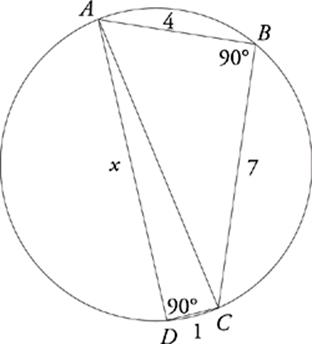
Figure 10
If you draw diameter AC, you divide the quadrilateral ABCD into two triangles. Both ∠ADC and ∠ABC are inscribed angles that intercept a half-circle, or an arc of 180°. Since inscribed angles intercept arcs that have twice the measure of the angles themselves, that means that both ∠ADC and ∠ABC are 90° angles and that therefore, ΔADC and ΔABC are right triangles that share a hypotenuse. This hypotenuse is the key to finding the length of segment AD.
Because you know the lengths of the legs of right triangle ABC (AB = 4 and BC = 7), you can use the Pythagorean theorem to find the hypotenuse”s length, 42 + 72 = c2. So c = ![]() . Once you know that the hypotenuse of both triangles has a length of
. Once you know that the hypotenuse of both triangles has a length of ![]() , you can use the Pythagorean theorem again to find the length of the missing leg of the other right triangle.
, you can use the Pythagorean theorem again to find the length of the missing leg of the other right triangle.
12 + x2 = ![]()
1 + x2 = 65
x2 = 64
x = 8
The segment AD must therefore have a length of 8. The correct answer is (C).
49 E The segment from (0, 0) to (−2, 2) has a length of 2![]() , or 2.83 (you can think of it as the diagonal of a square with sides 2 units long, or the hypotenuse of a 45°-45°-90° triangle). If you sketch this line segment, you”ll see that there are two possible locations for the third vertex of an equilateral triangle constructed from that segment.
, or 2.83 (you can think of it as the diagonal of a square with sides 2 units long, or the hypotenuse of a 45°-45°-90° triangle). If you sketch this line segment, you”ll see that there are two possible locations for the third vertex of an equilateral triangle constructed from that segment.
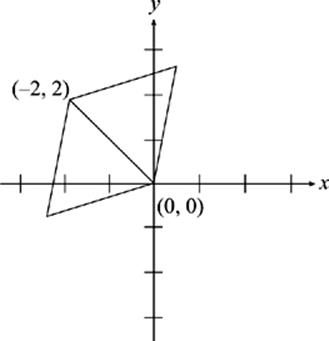
Before you start doing more complicated calculations, make the best sketch you can of the situation that”s described. You may find that you can eliminate a few answer choices just by looking at your sketch and guesstimating. On this question, if you can draw the figure accurately, the answer is obviously (E).
If not, there are a couple of ways to find the coordinates of these vertices, but the simplest way is to use trigonometry. Let”s start with the upper vertex. Draw an altitude from this point to the x-axis to produce a right triangle.

Since the hypotenuse of this triangle is one side of the equilateral triangle, you know it has a length of 2![]() , or 2.83. The Rule of 180° also lets you figure out the measure of the lower acute angle in this right triangle. It must measure 75°, since it forms a straight line with the 45° and 60° angles. All you need to find the coordinates of the third vertex are the legs of this right triangle. Trigonometry is the easiest way to find them. The length of the horizontal leg, adjacent to the 75° angle, will be (cos 75°)(2
, or 2.83. The Rule of 180° also lets you figure out the measure of the lower acute angle in this right triangle. It must measure 75°, since it forms a straight line with the 45° and 60° angles. All you need to find the coordinates of the third vertex are the legs of this right triangle. Trigonometry is the easiest way to find them. The length of the horizontal leg, adjacent to the 75° angle, will be (cos 75°)(2![]() ) = (0.26)(2.83) = 0.73. The length of the vertical leg will be (sin 75°)(2
) = (0.26)(2.83) = 0.73. The length of the vertical leg will be (sin 75°)(2![]() ) = (0.97)(2.83) = 2.73. The coordinates of the third vertex in this position will therefore be (0.73, 2.73).
) = (0.97)(2.83) = 2.73. The coordinates of the third vertex in this position will therefore be (0.73, 2.73).
50 A The x-intercepts of a graph are the places where y = 0. To solve 0 = x2 − 9x + 19.25, use the quadratic formula, x =  . In the given equation, a = 1, b = −9, and c = 19.25. Plugging these values into the quadratic formula gives you x = 3.5 or 5.5. These points are both on the x-axis, so the distance between them is simply 2.0.
. In the given equation, a = 1, b = −9, and c = 19.25. Plugging these values into the quadratic formula gives you x = 3.5 or 5.5. These points are both on the x-axis, so the distance between them is simply 2.0.
Another way to approach this is to multiply the equation through by 4 to clear out the decimal, and then factor. You get 0 = 4x2 − 36x + 77, which factors to 0 = (2x − 7)(2x − 11). This makes the x-intercepts ![]() and
and ![]() ; their difference is 2. Perhaps the quickest method would be to graph y = x2 − 9x + 19.25 on your calculator and see where the graph crosses the x-axis.
; their difference is 2. Perhaps the quickest method would be to graph y = x2 − 9x + 19.25 on your calculator and see where the graph crosses the x-axis.